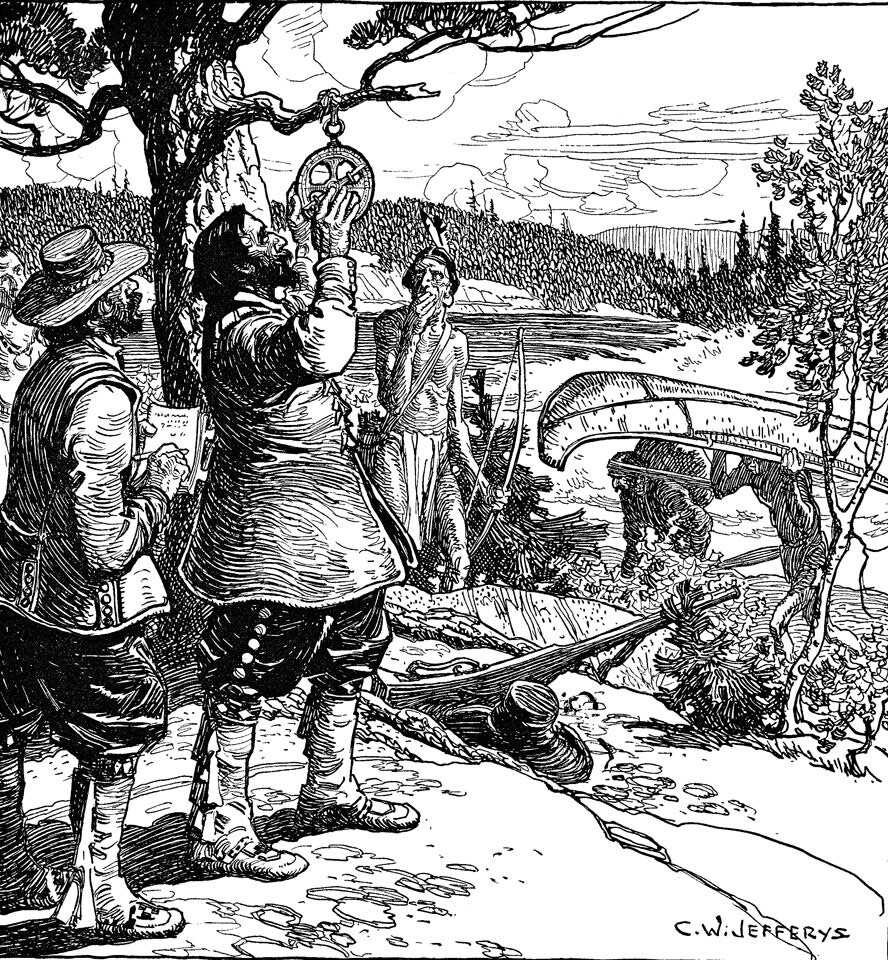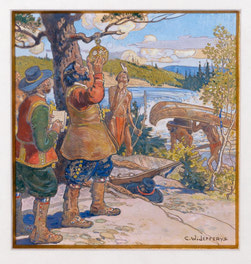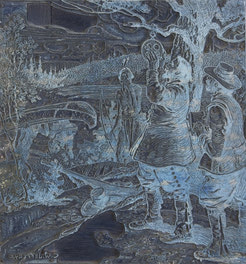Champlain Taking an Observation with the Astrolabe
Also titled: Champlain on the Ottawa, 1613
1928
- Credit: Library and Archives Canada, Acc. No. 1972-26-84
Copyright: Expired
Exhibition History
Remarks
C.W. Jefferys' notes about this picture in Dramatic Episodes in Canada’s Story
In 1613 Champlain made a journey up the Ottawa River, at that time unknown to the white man. Like all early explorers, Champlain hoped that it led to the sea - that sea which stretched to the Far East of Asia. The year before there had come to his ears a strange tale that seemed to encourage his hope. He had sent a young man named Nicolas Vignau to live among the Algonquins on the upper Ottawa to learn their language and explore their country. He returned with a story that he had seen the North Sea, on the shores of which he had found the wreck of an English ship, whose crew had been killed by the Indians, all except a boy who was still living among them. The story seemed probable. It was known that Henry Hudson had made a voyage to the Northern seas two years before, and that since then no word had been heard of him. Vignau swore that he had followed the Ottawa to a lake which emptied into the North Sea. Persuaded, after much questioning, that the tale was true, Champlain resolved to explore the route for himself' with Vignau and three other French men and an Indian he started up the Ottawa at the end of May' 1613.
With great difficulty they made their way hauling their canoe against the swift current, or portaging around rapids, until they reached Morrison's Island, just below Allumette Island. Here they met a band of Algonquins who, on hearing the object of Champlain's journey, told him that Vignau had never been to the sea, but had spent the whole winter with them. Vignau confronted with their statements, fell on his knees, confessed that his story was a lie and begged for mercy. Champlain, disappointed in his hopes, with difficulty controlled his anger at the deception. "Overcome with wrath," he says, he had him removed, being unable to endure him any longer in my presence." The imposter had foolishly hoped that he would be rewarded for his supposed discoverv, and that Champlain would not undertake the difficult task of verifying his story. With the disclosure of Vignau's ignorance of the route, and the refusal of the Indians to guide him through the unknown territory, Champlain was forced to give up his search and turn back. On their return to the St. Lawrence, Vignau made a public confession, and was pardoned on condition that he would continue to live among the Indians and gather further information.
In his account of this journey, Champlain records his latitude at various places with a fair degree of accuracy, up to a point some distance below Allumette island. Beyond this there is no record of his latitude in his journal. At this point, known today as Gould's Landing, he left the Ottawa, to avoid the long bend by way of Lake Coulonge, and struck off in a straight line through small lakes and streams to regain the river farther up. Here, he says, he had to make a difficult portage, heavily laden with his cloak, arquebus, etc.
Navigators and travellers in the Seventeenth Century, such as Champlain, found their way by means of the compass, and made out their positions by the use of the astrolabe. The astrolabe. was a flat circular plate of brass divided into degrees, across the face of which moved a bar, pivoted on the centre of the circle. The bar was-pierced with an eyelet, through which the traveller sighted the sun's elevation above the horizon, and thus was able to calculate the degree of latitude, and find out where he was.
In August 1867, 254 years after Champlain's journey, a man working in the woods near where the explorer had left the river, turned up a strange brass object, bearing the word "Paris" and the date "1603" It was, most probably Champlain's astrolabe, dropped as he struggled through the dense bush over the. portage. There, for over two and a half centuries, it had lain hidden under the fallen and decayed leaves and tangled undergrowth of the forest. The farmer's children used it for a plaything, and neighbouring settlers puzzled, over it. In time it was sold, and after passing through several hands, was bought by a collector of astronomical instruments in the United States and is now in his possession. Some day, it is to be hoped, it may come back to Canada, and be placed in the Archives at Ottawa, the latitude of which place it helped to mark so many Years ago.
The picture shows Champlain looking through the eyepiece of the astrolabe. In order to take a correct observation, it was necessary to hold the astrolabe in a perpendicular position. It was therefore held by a ring at the top on the thumb or finger of the observer, or suspended from the projecting branch of a tree. The astrolabe was somewhat thicker at the bottom, so as to give it greater steadiness when suspended, and to ensure an absolutely perpendicular position. Some pictures of Champlain show him holding the astrolabe by its base, but this was not the correct way of using the instrument. One of Champlain's men is recording his reading of the degree of elevation in the note book which Champlain tells us that he carried on his journey. Some Indians watch with wonder the white man's magic "medicine," while others of the party carry the canoe and baggage over the portage beside the rapids.
Publication References
- Jefferys, Charles W. (1930) Dramatic Episodes in Canada’s Story, p.19
- Guillet, Edwin C. (1933) Early life in Upper Canada
-
Paterson, Gilbert. (1933) Canada from the Earliest Times to the Present. p. 27
-
Paterson, Gilbert. The Story of Britain and Canada. Toronto, Ryerson, 1933. 233 p
- Jefferys, C. W. (1934) Canada’s Past in Pictures, p.27
- Guillet, Edwin and Mary (1939) The Pathfinders of North America
- Jefferys, Charles W. (1942) The Picture Gallery of Canadian History Vol. 1, p.92
-
Long, Morden H. A History of the Canadian People: vol. 1, New France. Toronto, Ryerson, 1942. 376 p. Illus.
-
“Canada’s storied path to Dominion Day.” In The Globe and Mail, June 30, 1945, p. 13. Illus.
-
“A heritage for Canadians.” In Imperial Oil Review, Sept. 1952, p. 2-7. Illus.
- Wallace, W. Stewart. (1953) By Star and Compass
-
Colgate, William. “C.W.J.: a Victorian portrait.” In The Educational Record of the Province of Quebec, v. LXXX, No. 3, July-Sept., 1954, p. 142-150. Illus.
-
Encyclopedia Canadiana. Toronto, Grolier, 1957-1958. 10 v. Illus.
- Hardwick, Francis C. (1973), ed. The Helping Hand: The Debt of Alexander Mackenzie and Simon Fraser to Indian Canadians
-
“Heritage transfer: Jefferys collection goes to archives.” In Esso Reporter, May 1972, p. 2-3. Illus.
-
Duffy, Dennis. “Art-history: Charles William Jefferys as Canada’s curator.” In Journal of Canadian Studies, Nov. 1976, p. 3-18. Illus.
-
Fulford, Robert. “Our history mapped out in all its vivid grandeur.” In Toronto Star, Dec. 10, 1983, p. F5. Illus.
-
Byers, Mary and McBurney, Margaret. “Group of Seven convened in the parlor.” In Globe and Mail, Dec. 13, 1984, p. L4. Illus.
-
Horn, Frank Taiotekane. “War was not waged against Champlain [letter to ed.].” In Globe and Mail, Feb. 6, 1988, p. D7. Illus.
-
Boucher, Louis N. “Chaudiere Falls in the Outaouais Region.” In Encyclopedia of French cultural heritage in North America. 11 p. Illus. http://www.ameriquefrancaise.org/en/
-
Ontario Heritage Trust. Artistic representations. 10 p. Illus. www.heritagetrust.on.ca/.../Artistic-representations.aspx
-
Nyznik, Jessica. “Champlain remembered.” In The Examiner, Peterborough, August 26, 2015, p. A3. Illus.
-
“New book! The launch of a new book…Finding Champlain’s Dream… In Peterborough Examiner, Thursday, August 27, 2015, p. A9. Illus.
- Begbie Contest Society. “Canadian primary sources in the classroom: New France.” July 2017, 109 p. Illus. http://www.begbiecontestsociety.org/NewFrance.htm Accessed July 27, 2017.
-
“Early Canada Historical Narratives -- CHAMPLAIN & THE FUR TRADE.” Accessed July 23, 2017. http://www.uppercanadahistory.ca/finna/finna2.html.








Comments